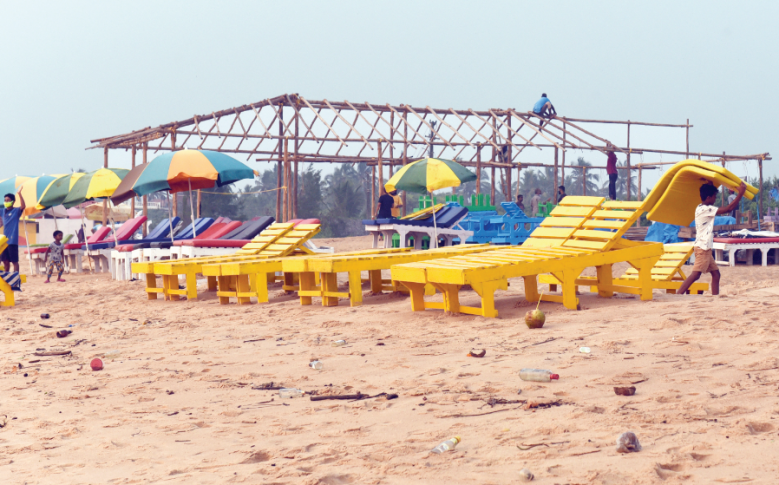
Thirty years ago, when the Indian littoral showed initial signs of haphazard development, the CRZ regulations were promulgated. The coastal environmental laws were first ratified in 1991 with the express objective to conserve and protect coastal stretches, its unique environment and its marine area, taking into account the dangers of natural hazards. Coastal regulations were revisited in 2011, followed by new laws in 2019. However, since its inception, a spate of multiple amendments with relaxations, issued over the last 30 years, has adulterated the essence of CRZ. The latest (draft) amendment, dated November 1, 2021 deals with (among others) relaxation of norms for beach shacks. This perilous decree is probably the last nail in the coffin of CRZ.
In a notification of November 1, 2021, the MoEF has proposed further amendments in the Coastal Regulation Zone Notification 2019 for beach shacks, as described in Section 2 of the draft. In paragraph 5.1.2, for sub-clause (xviii), the following sub-clauses shall be inserted: “(xix) purely temporary and seasonal structures (shacks) customarily put up and may be retained during the monsoon season with adequate precautions”. The note further asserts: “In respect of state of Goa and Maharashtra, such structures (shacks), customarily put up between the months of September to May, may be retained during the months of June to August, provided that the facilities available in these structures shall remain non-operational during the months of June to August”.
The location and installation of shacks along the coastline of Goa are governed by Goa Beach Shack Policy which is updated periodically. A survey along sandy beaches shows three categories of temporary structures, although difficult to distinguish between them: (i) Shacks on upper dry beach are fixed on pre-specified locations seaward of the dune, all duly approved by the tourism department, as observed along the congested Calangute – Baga stretch; (ii) Shacks in private properties, all landward of the High Tide Line, and obviously located on the dune fields, Arambol being just one of the typical examples; (iii) Shacks that impinge on the vegetation line and pioneer dunes, most of which do not have approvals, and yet can be found all along the sandy coast. According to the shack policy, shacks are to be located exclusively on dry beach ahead of the dune line; however, an adequate setback of at least 3 metres between the dune vegetation line and the back wall of the shack was strongly recommended for the entire sandy coast of Goa. Shacks should not and cannot interfere or damage dunes, uproot vegetation or trample it; human activity/kitchens cannot be allowed behind shacks; access to the beach and/or shacks should be through designated pathways; movement through sand dunes fields should be strictly prohibited.
In such a scenario, in-operational temporary structures need not be dismantled during monsoons. Month of June to August is the precise period when the oceanographic and meteorological forces are the most hazardous along the seafront, making the entire west coast of India highly vulnerable and exposed to cyclonic winds and marine invasion. Being a cause of immense concern, several issues and questions arise:
(1)
Effect of heavy monsoonal winds(2)
July 11, 2021, Goa experienced stormy weather, with heavy rainfall and wind speeds greater than 40 km/h along the coast. In May 2021, cyclone Tauktae had already taught yet another lesson with cyclonic winds with speeds greater than 200 km/h that induced a massive damage along the coast. When heavy damage was inflicted on residential dwellings all over Goa, will the isolated shacks facing the mighty ocean be able survive the onslaught of powerful westerly winds? (2) Influence of sea water incursions on the beach: Marine transgressions and frequent flooding of beaches occurred even during fair weather. In May, June and July 2021, the coast of Goa was under the grip of squally weather with high onrushing waves as high as 3.5 to 4 metres that invaded several beaches. (3) Uprooted vegetation: Several shacks have encroached on vegetation. Dune vegetation will not recuperate during rains, if shacks are not removed. (4) Damage by shacks atop sand dunes: Almost all private shacks are found on pioneer dunes. Levelled strips will not rejuvenate if shacks remain put. (5) Impact of retaining walls: Shacks also build low walls; beaches backed by hard structures suffer irreversibly, loose sand, decrease in width, erode away and disappear. (6) Beach erosion due to hard structures: Sea walls and revetments enhance erosion. The ultimate consequence of permanent shacks will lead to drastic geomorphological alterations in the form of beach and dune sand loss.The new CRZ amendment 2021 thus permits temporary beach shacks to remain in place, marooned on the beach, provided they are in-operational. This decision is bizarre, as deserting beach shacks in hazardous conditions will induce profound effects on coastal geomorphology, detrimental to the shacks itself. Beach configuration alters every day, at every tide, and thus undergoes monthly, seasonal and annual shoreline adjustments.
Morphological alterations can be drastic during inclement weather. As such, irrespective of which part of a beach a structure is located, it will be stranded on an open sea front, devoid of natural protection, and hence highly vulnerable to heavy winds along with a merciless invasion by powerful ocean waves. There is no way wooden structures can survive.
(Dr Antonio Mascarenhas is a former Scientist, NIO, Goa)
